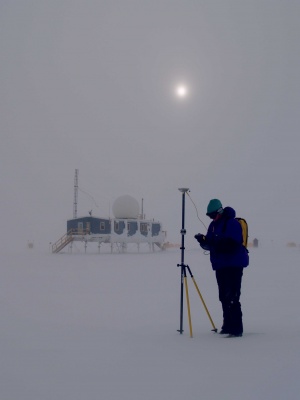If you wish to contribute or participate in the discussions about articles you are invited to contact the Editor
Real Time Kinematics
| Fundamentals | |
|---|---|
| Title | Real Time Kinematics |
| Author(s) | See Credits section |
| Level | Basic |
| Year of Publication | 2011 |
Real Time Kinematics (RTK) satellite navigation is a DGNSS technique that uses the carrier phase measurements of GNSS signals. RTK is commonly used in land and hydrographic survey. The positioning accuracy obtained is of the order of centimeter-level. When only GPS signals are used, the RTK system is named Carrier-Phase Enhancement, CPGPS.[1]
No->Real Time Kinematic (RTK) satellite navigation is a DGNSS technique used in land survey and in hydrographic survey based on the use of carrier phase measurements of the GPS, GLONASS and/or Galileo signals where a single reference station provides the real-time corrections, providing up to centimeter-level accuracy. When referring to GPS in particular, the system is also commonly referred to as Carrier-Phase Enhancement, CPGPS.[1]
Introduction RTK
The RTK technique follows the same general principle as classical DGNSS, but instead of using corrections to C/A code pseudoranges, it uses the carrier phase as its signal.[1]
The RTK technique consists on a rover user that applies real-time corrections provided by a base station. In the classical DGNSS Technique, there are also 2 receivers, one at a known location (base station) and one at an unknown position, that see the same GNSS satellites in common. By fixing the location of the base station, the other location may be found either by computing corrections to the position of the unknown receiver or by computing corrections to the pseudoranges. In the classical DGNSS technology, only corrections to C/A code pseudoranges are being transmitted, which brings rover positional errors down to values about 1 m for distances between rover and base station of a few tens of kilometers.[1]
The military-only P(Y) signal sent by the same satellites is clocked by receivers ten times as fast, so with similar techniques the receiver will be accurate to about 30 cm. Therefore, in RTK system using the satellite's carrier phase as its signal, the improvement in accuracy is potentially very high if one continues to assume a 1% accuracy in locking. The difficulty of the use of carrier phase data comes at a cost in terms of overall system complexity because the measurements are ambiguous by an integer (i.e. every cycle of the carrier is similar to every other). Therefore, the key of the RTK technique is the "Ambiguity Resolution". [1]
The first RTK Systems that were developed use a single base station and a number of rover units. The base station re-broadcasts the phase of the carrier that it measured, and the mobile units compare their own phase measurements with the ones received from the base station. This allows the units to calculate their relative position to millimeters, although their absolute position is accurate only to the same accuracy as the position of the base station. The typical nominal accuracy for these dual-frequency systems is 1 centimeter ± 2 parts-per-million (ppm) horizontally and 2 centimeters ± 2 ppm vertically. In areas with a large GPS surveying activity, the RTK Systems have evolved to Network RTK systems making use of a network of reference stations.[2][1]
The use of RTK technique is very frequent in surveying. Other applications are autodrive/autopilot systems or precision farming.[1]
RTK Related Articles
The following articles include further information about different important topics related to RTK:
Credits
Edited by GMV. Most of the information in this article includes text taken from Wikipedia with minor adaptation,[1] provided under Creative Commons Attribution-ShareAlike License.
Notes

